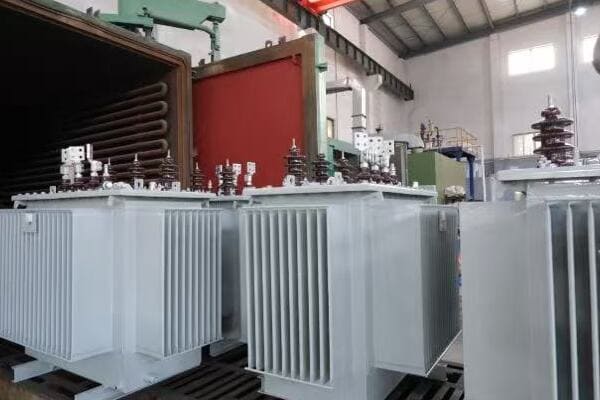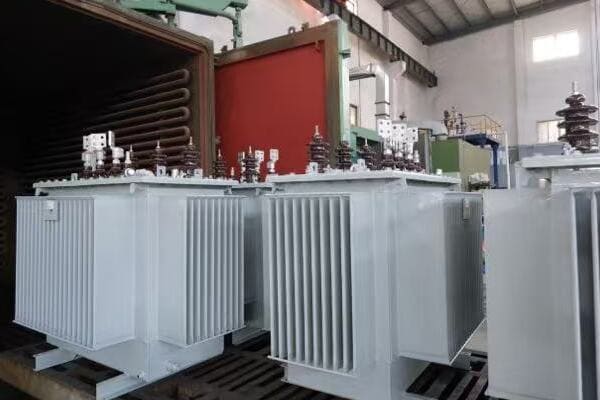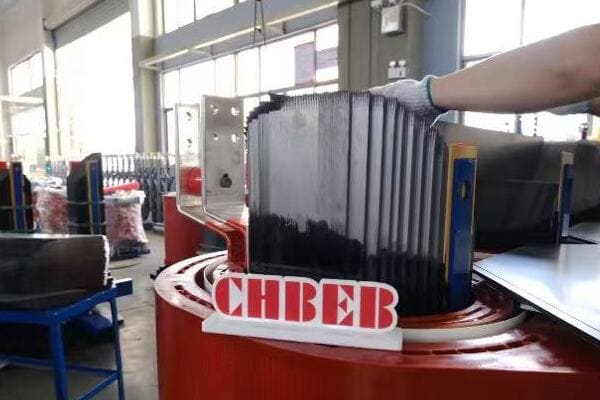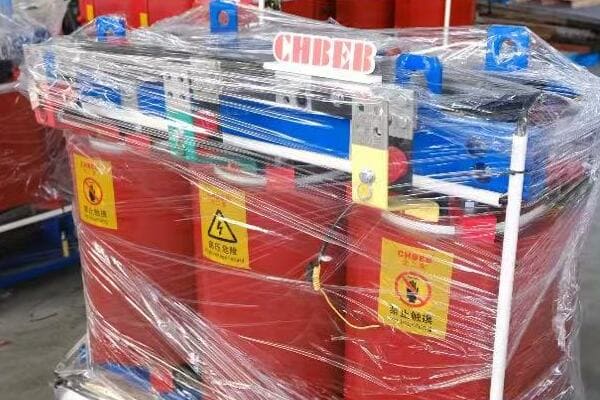Distribution Transformer Diagram for Residential, Industrial, and Utility Installations?
Are you struggling to understand the nuances of distribution transformer diagrams across different installation types? You’re not alone. Many engineers and project managers find themselves confused when faced with the varied requirements of residential, industrial, and utility installations. But what if you could easily interpret and apply these diagrams to ensure optimal performance and safety in any setting?
Distribution transformer diagrams vary by installation type—residential, industrial, or utility—based on voltage levels, load characteristics, and layout needs. This guide explains how to read and apply these diagrams for different use cases, helping project engineers and utility planners ensure safe and efficient system integration.

In this comprehensive guide, I’ll walk you through the key aspects of distribution transformer diagrams for various installation types. Whether you’re working on a residential project, an industrial facility, or a utility-scale installation, this article will provide you with the insights you need to navigate these crucial diagrams effectively.
What Is a Distribution Transformer Diagram?
Have you ever wondered why distribution transformer diagrams look so complex? These intricate drawings serve a crucial purpose, but their complexity can be overwhelming. So, what exactly are these diagrams, and why are they so important for different installation types?
A distribution transformer diagram is a technical drawing that illustrates the internal connections, components, and electrical pathways of a transformer used in power distribution systems. It includes wiring schematics, connection points, and component layouts specific to residential, industrial, or utility applications. These diagrams are essential for proper installation, maintenance, and troubleshooting in various settings.

Understanding Distribution Transformer Diagrams
Let’s break down the key elements of these diagrams:
- Basic Components
- Connection Representations
- Safety Features
- Application-Specific Elements
Basic Components
All distribution transformer diagrams share some common elements:
- Primary and secondary windings
- Core representation
- Bushing terminals
- Tap changer (if applicable)
I remember a project where a junior engineer overlooked the tap changer representation, leading to incorrect voltage settings. This experience highlighted the importance of understanding even the basic components in these diagrams.
Connection Representations
Diagrams show how the transformer is connected to the system:
- Primary side connections (usually higher voltage)
- Secondary side connections (lower voltage for distribution)
- Grounding points
- Vector group notation (e.g., Dyn11)
During a recent industrial installation, the correct interpretation of the vector group notation was crucial in ensuring proper phase relationships between primary and secondary sides.
Safety Features
Safety is paramount, and diagrams reflect this:
- Surge arresters
- Fuse locations
- Protective relays
- Isolation points
I once worked on a utility project where overlooking a surge arrester in the diagram led to inadequate protection planning. This taught me to always pay close attention to safety features in transformer diagrams.
Application-Specific Elements
Different installations require specific elements:
- Residential: Focus on single-phase connections, compact design
- Industrial: Emphasis on load capacity, multiple output circuits
- Utility: Inclusion of metering equipment, SCADA interfaces
Here’s a quick reference table for diagram elements across applications:
| Element | Residential | Industrial | Utility |
|---|---|---|---|
| Voltage Levels | Low (e.g., 240V) | Medium (e.g., 480V) | High (kV range) |
| Phase Configuration | Often single-phase | Typically three-phase | Three-phase |
| Protection Devices | Simple fusing | Complex relay systems | Advanced protection schemes |
| Metering | Basic | Power quality monitoring | Advanced metering infrastructure |
Understanding these elements is crucial for correctly interpreting and applying distribution transformer diagrams. In my experience, the ability to quickly identify application-specific features in a diagram can significantly streamline the planning and installation process.
As we delve deeper into the variations across different installation types, keep in mind that these diagrams are not just technical drawings – they’re roadmaps for ensuring safe, efficient, and reliable power distribution in diverse settings.
Diagram Variations by Application Type?
Are you finding it challenging to distinguish between transformer diagrams for different applications? You’re not alone. Many professionals struggle to identify the unique features that set residential, industrial, and utility transformer diagrams apart. But why do these variations matter, and how can understanding them improve your project outcomes?
Distribution transformer diagrams vary significantly based on their application. Residential diagrams focus on low voltage, compact layouts, and safety features for domestic use. Industrial diagrams emphasize higher capacities, multi-load integration, and power quality monitoring. Utility diagrams showcase high voltage connections, advanced protection schemes, and SCADA integration for grid management. Understanding these variations is crucial for proper installation and system integration.

Exploring Application-Specific Diagram Features
Let’s dive into the unique characteristics of each application type:
- Residential Transformer Diagrams
- Industrial Transformer Diagrams
- Utility Transformer Diagrams
Residential Transformer Diagrams
Residential diagrams have specific features tailored for domestic power distribution:
- Low voltage focus (typically 120/240V in North America)
- Single-phase or split-phase configurations
- Compact design representations
- Emphasis on safety features for public areas
I recall a project where we were retrofitting an old neighborhood with updated transformers. The compact nature of the residential diagrams was crucial in planning installations in space-constrained urban areas.
Key elements in residential diagrams:
- Simplified protection schemes (often just fuses)
- Clear labeling for service drops
- Grounding representations for safety
- Weatherproof enclosure details
Industrial Transformer Diagrams
Industrial applications require more complex diagrams:
- Higher voltage and capacity ratings
- Three-phase configurations
- Multiple secondary outputs for diverse loads
- Power quality monitoring integration
During an industrial park development, I noticed how the transformer diagrams had to account for vastly different load types – from office buildings to manufacturing plants. This variety was clearly reflected in the complexity of the diagrams.
Important features in industrial diagrams:
- Detailed load-side connection options
- Power factor correction equipment
- Harmonic mitigation devices
- Advanced protection relay schematics
Utility Transformer Diagrams
Utility-scale diagrams are the most complex:
- High voltage primary connections (often in kV range)
- Substation integration details
- Advanced protection and control schemes
- SCADA system interfaces
I once worked on a smart grid project where the utility transformer diagrams had to incorporate advanced monitoring and control features. The level of detail in these diagrams was crucial for successful integration with the broader grid management systems.
Critical elements in utility diagrams:
- Detailed primary and secondary bushing arrangements
- Tap changer mechanisms and controls
- Extensive metering and monitoring points
- Fault detection and isolation schemes
Here’s a comparison table of key diagram features across applications:
| Feature | Residential | Industrial | Utility |
|---|---|---|---|
| Voltage Levels | Low (120/240V) | Medium (480V-4.16kV) | High (>4.16kV) |
| Phase Configuration | Single/Split-phase | Three-phase | Three-phase |
| Protection Complexity | Low | Medium | High |
| Size Representation | Compact | Medium | Large |
| Control Systems | Minimal | Moderate | Extensive |
| Environmental Factors | Weather resistance | Harsh conditions | Substation environment |
Understanding these variations is crucial for several reasons:
- Proper equipment selection and sizing
- Ensuring compliance with application-specific standards
- Facilitating effective communication between designers, installers, and operators
- Optimizing installation layouts and space utilization
- Enhancing safety and reliability in diverse operating environments
In my experience, the ability to quickly identify and interpret these application-specific features can significantly streamline project planning and execution. I remember a case where an industrial diagram was mistakenly used as a reference for a residential installation. The overengineered solution led to unnecessary costs and complications – a situation that could have been easily avoided with proper diagram identification.
As we continue to explore the nuances of distribution transformer diagrams, keep in mind that these variations are not just technical distinctions. They represent fundamental differences in how power is distributed and utilized across different sectors of our electrical infrastructure. By mastering these distinctions, you’ll be better equipped to handle diverse projects and ensure optimal performance in any setting.
Regional Differences in Diagram Design?
Have you ever noticed how transformer diagrams can vary significantly from one region to another? This variation isn’t just a matter of style – it reflects important differences in standards, practices, and environmental factors across different parts of the world. But why do these regional differences exist, and how can understanding them help you in your projects?
Regional differences in distribution transformer diagrams stem from varying standards, environmental conditions, and local practices. Middle Eastern diagrams often emphasize high-temperature designs and IEC standards. Southeast Asian diagrams focus on compact distribution and multi-load branching. Latin American diagrams prioritize installation clarity and maintainability. Understanding these regional nuances is crucial for international projects and compliance with local regulations.
Exploring Regional Diagram Characteristics
Let’s examine the unique features of transformer diagrams in different regions:
- Middle Eastern Diagram Designs
- Southeast Asian Diagram Approaches
- Latin American Diagram Practices
Middle Eastern Diagram Designs
Middle Eastern transformer diagrams have distinct characteristics:
- Emphasis on high-temperature operation
- Preference for IEC standard symbols
- Detailed dust and sand protection features
- Focus on oil preservation systems
I once worked on a project in Saudi Arabia where the transformer diagram had to include specific details about enhanced cooling systems and sand-resistant enclosures. This experience highlighted the importance of adapting designs to harsh desert environments.
Key elements in Middle Eastern diagrams:
- Extended temperature range specifications
- Detailed insulation class notations
- Sand and dust filtration system representations
- Enhanced oil circulation and cooling diagrams
Southeast Asian Diagram Approaches
Southeast Asian diagrams often reflect unique regional needs:
- Compact designs for urban density
- Emphasis on moisture resistance
- Multi-load branching configurations
- Integration with local grid peculiarities
During a project in Singapore, I noticed how the transformer diagrams had to account for extremely space-constrained installations and high humidity environments. The level of detail in spatial planning within these diagrams was impressive.
Important features in Southeast Asian diagrams:
- Space-saving layout representations
- Detailed moisture sealing techniques
- Multiple low-voltage output configurations
- Compatibility with local voltage fluctuation ranges
Latin American Diagram Practices
Latin American transformer diagrams often prioritize:
- Clear installation instructions
- Robust grounding schemes
- Flexibility for varied voltage standards
- Easy maintenance access points
I recall a project in Brazil where the emphasis on clear, visually intuitive diagrams was crucial for coordinating with local installation teams. The diagrams included detailed step-by-step installation guides, which greatly facilitated on-site work.
Critical elements in Latin American diagrams:
- Bilingual labeling (often Spanish/Portuguese and English)
- Detailed grounding and bonding representations
- Voltage range adaptability features
- Maintenance access point highlights
Here’s a comparison table of regional diagram characteristics:
| Feature | Middle East | Southeast Asia | Latin America |
|---|---|---|---|
| Environmental Focus | Heat and sand resistance | Moisture and space efficiency | Versatility and ease of maintenance |
| Preferred Standards | IEC | Mix of IEC and local standards | Often compatible with both IEC and ANSI |
| Key Design Emphasis | Cooling systems | Compact multi-load designs | Clear installation guidance |
| Unique Elements | Sand filters, extended temp. ranges | Space-saving layouts, humidity protection | Bilingual labels, flexible voltage settings |
Understanding these regional differences is crucial for several reasons:
- Ensuring compliance with local regulations and standards
- Adapting designs to specific environmental challenges
- Facilitating effective communication with local teams and authorities
- Optimizing transformer performance for regional power quality issues
- Streamlining installation and maintenance processes in different cultural contexts
In my experience, recognizing and adapting to these regional nuances can make or break international projects. I remember a case where a European-designed transformer diagram was used without modification for a Southeast Asian project. The lack of consideration for the region’s high humidity and space constraints led to significant on-site modifications and delays.
As we continue to explore the global landscape of distribution transformer diagrams, it’s important to remember that these regional differences are not just technical curiosities. They represent the culmination of local experiences, environmental adaptations, and regulatory evolutions. By mastering these regional variations, you’ll be better equipped to handle diverse international projects and ensure optimal transformer performance in any global context.
How Top Brands Customize Diagrams for Each Use Case?
Have you ever wondered how leading transformer manufacturers adapt their diagrams for different markets and applications? This customization is not just about branding – it’s a crucial aspect of ensuring that transformers meet specific regional and application needs. But how do top brands approach this customization, and what can we learn from their practices?
Top transformer brands customize their diagrams based on regional standards and application-specific requirements. ABB often uses IEC symbols with heat-optimized designs for Middle Eastern projects. TBEA excels in compact, multi-load diagrams for Southeast Asian markets. Shunted focuses on clear isolation structures for commercial buildings. Siemens integrates detailed SCADA symbols for Latin American utility projects. Understanding these customizations helps in selecting the right transformer for specific use cases.

Brand-Specific Diagram Customization Approaches
Let’s examine how some top brands tailor their transformer diagrams:
- ABB’s Middle Eastern Adaptations
- TBEA’s Southeast Asian Specializations
- Shunted’s Commercial Building Focus
- Siemens’ Latin American Utility Designs
ABB’s Middle Eastern Adaptations
ABB’s approach to Middle Eastern markets includes:
- Extensive use of IEC standard symbols
- Enhanced heat dissipation design representations
- Detailed sand and dust protection features
- Emphasis on oil preservation systems
I once worked with ABB on a large substation project in the UAE. Their diagrams included intricate details of enhanced cooling systems and sand-resistant enclosures, which were crucial for the harsh desert environment.
Key features in ABB’s Middle Eastern diagrams:
- Extended temperature range specifications
- Detailed insulation class notations
- Sand and dust filtration system representations
- Enhanced oil circulation and cooling diagrams
TBEA’s Southeast Asian Specializations
TBEA’s diagrams for Southeast Asian markets focus on:
- Compact designs for urban density
- Multi-transformer interlinking schemes
- Clear grounding and isolation representations
- Adaptation to local grid characteristics
During a recent project in Malaysia, I was impressed by TBEA’s approach to designing compact transformer layouts that could fit into tight urban spaces while still maintaining clear safety and maintenance access points.
Notable elements in TBEA’s Southeast Asian diagrams:
- Space-efficient layout representations
- Detailed moisture sealing techniques
- Multiple low-voltage output configurations
- Local voltage fluctuation compensation features
Shunted’s Commercial Building Focus
Shunted’s diagrams for commercial applications emphasize:
- Clear representation of dry-type transformer structures
- Detailed ventilation and cooling layouts
- Noise reduction feature illustrations
- Integration with building management systems
I recall a project where Shunted’s clear diagram of a dry-type transformer’s isolation structure was instrumental in convincing a client of its suitability for their high-rise office building.
Important aspects of Shunted’s commercial building diagrams:
- Thermal management system details
- Acoustic enclosure representations
- Fire safety feature illustrations
- Building automation system interface points
Siemens’ Latin American Utility Designs
Siemens’ approach to Latin American utility projects includes:
- Detailed SCADA integration symbols
- Robust grounding scheme representations
- Flexibility for varied regional voltage standards
- Clear maintenance access point illustrations
Working on a smart grid project in Brazil, I saw firsthand how Siemens’ detailed SCADA integration diagrams facilitated seamless communication between the transformers and the broader grid management system.
Key elements in Siemens’ Latin American utility diagrams:
- Comprehensive SCADA symbol sets
- Detailed grounding and bonding representations
- Voltage range adaptability features
- Maintenance-friendly design highlights
Here’s a comparison table of brand-specific diagram features:
| Brand | Regional Focus | Key Diagram Features | Unique Selling Point |
|---|---|---|---|
| ABB | Middle East | IEC symbols, heat optimization | Desert-ready designs |
| TBEA | Southeast Asia | Compact, multi-load layouts | Urban space efficiency |
| Shunted | Commercial Buildings | Clear isolation structures | Building integration |
| Siemens | Latin American Utilities | Detailed SCADA integration | Smart grid readiness |
Understanding these brand-specific approaches is valuable for several reasons:
- Selecting the most suitable transformer for specific regional and application needs
- Anticipating potential challenges in installation and operation3. Leveraging brand expertise for particular environmental or operational conditions
- Facilitating smoother integration with existing systems or infrastructure
- Optimizing maintenance and operational procedures based on manufacturer-specific features
In my experience, recognizing these brand-specific customizations can significantly impact project success. I remember a case where we initially considered a generic transformer design for a Southeast Asian urban project. After reviewing TBEA’s specialized compact designs, we realized the significant space savings and improved integration possibilities, which ultimately led to a more efficient and cost-effective installation.
As we navigate the diverse landscape of transformer diagrams, it’s crucial to remember that these brand customizations are not just marketing differentiators. They represent years of experience and adaptation to specific regional and application challenges. By understanding and leveraging these customized approaches, you can ensure that your transformer selections are optimally suited to the unique demands of each project.
Key Symbols and Layouts to Know?
Are you finding yourself puzzled by the array of symbols and layouts in distribution transformer diagrams? You’re not alone. Many engineers and technicians struggle to decipher these critical elements across different application types. But what if you had a clear guide to help you understand each symbol and layout, regardless of whether it’s for residential, industrial, or utility use?
Key symbols and layouts in distribution transformer diagrams vary by application but share common elements. Residential diagrams often feature simple single-phase symbols and compact layouts. Industrial diagrams include three-phase symbols, multiple load connections, and power quality monitoring layouts. Utility diagrams showcase complex protection schemes, SCADA symbols, and high-voltage connection layouts. Understanding these elements is crucial for accurate diagram interpretation and effective transformer installation.
Essential Symbols and Layouts Across Applications
Let’s break down the key elements you need to know:
- Common Symbols Across All Applications
- Residential-Specific Symbols and Layouts
- Industrial Diagram Elements
- Utility-Scale Diagram Features
Common Symbols Across All Applications
Certain symbols are universal across transformer diagrams:
- Transformer core: Usually represented by two or more parallel lines
- Windings: Typically shown as zigzag lines
- Bushings: Often depicted as small circles or rectangles on the transformer outline
- Ground symbols: Represented by multiple horizontal lines decreasing in length
I once worked on a project where a junior engineer confused bushing symbols with tap changer representations. This experience highlighted the importance of understanding even the most basic symbols in transformer diagrams.
Residential-Specific Symbols and Layouts
Residential diagrams have unique features:
- Single-phase symbols: Often simplified representations
- Service drop connections: Clear labeling for household connections
- Simple protection schemes: Basic fuse symbols
During a recent residential area upgrade, the clear representation of service drop connections in the diagrams was crucial for efficient installation and minimizing disruption to homeowners.
Industrial Diagram Elements
Industrial diagrams include more complex elements:
- Three-phase symbols: More detailed winding representations
- Multiple secondary outputs: Often labeled for different voltage levels
- Power factor correction equipment: Capacitor bank symbols
- Harmonic filter representations: Inductor and capacitor combinations
I recall a manufacturing plant project where the correct interpretation of power factor correction symbols in the diagram was essential for addressing the facility’s specific power quality needs.
Utility-Scale Diagram Features
Utility diagrams are the most complex:
- High voltage bushings: Detailed insulator representations
- SCADA interface symbols: Communication and control elements
- Advanced protection schemes: Relay and circuit breaker combinations
- Tap changer mechanisms: Detailed switching representations
In a recent smart grid project, understanding the SCADA interface symbols in utility transformer diagrams was critical for ensuring proper integration with the broader grid management system.
Here’s a quick reference table for key symbols across applications:
| Symbol Type | Residential | Industrial | Utility |
|---|---|---|---|
| Transformer Core | Simple dual-line | Detailed multi-line | Complex multi-section |
| Windings | Basic zigzag | Multiple zigzags | Detailed with taps |
| Protection | Fuse symbols | Relay and breaker combo | Complex protection schemes |
| Connections | Single-phase | Three-phase, multi-output | High voltage, SCADA links |
Key considerations when interpreting symbols and layouts:
- Always refer to the diagram’s legend or key for specific symbol meanings
- Pay attention to voltage levels indicated near connection points
- Note the differences in protection scheme complexity across applications
- Understand how layout reflects physical arrangement versus schematic representation
- Be aware of regional variations in symbol usage, especially in international projects
In my experience, proficiency in reading these symbols and layouts comes with practice and exposure to diverse diagrams. I encourage technicians and engineers to study diagrams from various manufacturers and for different applications, even when not directly working on a related project.
Remember, accurate interpretation of these symbols and layouts is not just about technical correctness; it’s about ensuring safety, efficiency, and reliability in transformer installations. Whether you’re working on a simple residential setup or a complex utility-scale project, a solid understanding of these elements will serve you well throughout your career in the power distribution field.
Best Practices for Installation Diagram Interpretation?
Are you finding it challenging to translate transformer diagrams into successful installations? This common struggle can lead to costly errors and safety risks if not addressed properly. But how can you ensure that you’re interpreting these crucial diagrams correctly, especially when dealing with different applications and regional variations?
Best practices for interpreting installation diagrams include: thoroughly reviewing legends and notes, cross-referencing with specifications, considering physical layout implications, verifying protection schemes, and understanding regional standards. For residential installations, focus on service connections. In industrial settings, pay attention to load distribution. For utility projects, carefully interpret control and monitoring interfaces. Always verify grounding and safety features across all applications.

Key Strategies for Effective Diagram Interpretation
Let’s explore essential practices for interpreting transformer installation diagrams:
- Pre-Installation Review Process
- Application-Specific Considerations
- Safety and Compliance Checks
- Practical Installation Tips
Pre-Installation Review Process
Before beginning any installation:
- Thoroughly review the legend and symbol key
- Cross-reference the diagram with written specifications
- Verify voltage levels and capacity ratings
- Check for any site-specific notes or special instructions
I once worked on a project where skipping the pre-installation review led to a misunderstanding of a custom symbol. This resulted in incorrect wiring that had to be completely redone, causing significant delays and additional costs.
Application-Specific Considerations
Different applications require focused attention on certain aspects:
Residential:
- Verify service drop connections
- Check for proper grounding representations
- Ensure compliance with local residential codes
Industrial:
- Pay close attention to load distribution across outputs
- Verify power factor correction and harmonic mitigation features
- Check for integration with existing industrial systems
Utility:
- Carefully interpret SCADA and control interface representations
- Verify high voltage connection details
- Ensure compatibility with utility-specific protection schemes
During a recent industrial installation, carefully interpreting the load distribution diagram was crucial in balancing power supply across various manufacturing processes, ultimately optimizing the facility’s energy efficiency.
Safety and Compliance Checks
Prioritize safety in your interpretation:
- Double-check all grounding and bonding representations
- Verify that protection devices are correctly represented and positioned
- Ensure compliance with relevant safety standards (e.g., NFPA, IEC)
- Check for any special environmental protection features
I recall a utility project where a misinterpretation of the grounding scheme in the diagram led to a potential safety hazard. Fortunately, our rigorous compliance check caught this before installation, avoiding what could have been a dangerous situation.
Practical Installation Tips
When moving from diagram to actual installation:
- Create a step-by-step installation checklist based on the diagram
- Mark up a copy of the diagram to note any site-specific adaptations
- Use the diagram to plan equipment positioning and cable routing
- Regularly refer back to the diagram during installation to ensure accuracy
Here’s a quick reference table for interpretation focus areas:
| Application | Key Focus Areas | Common Pitfalls |
|---|---|---|
| Residential | Service connections, grounding | Overlooking local code specifics |
| Industrial | Load balancing, power quality | Misinterpreting complex protection schemes |
| Utility | SCADA integration, HV connections | Underestimating control interface complexity |
Best practices for diagram interpretation across all applications:
- Always start with a thorough review of the entire diagram before focusing on details
- When in doubt, consult with the diagram creator or manufacturer for clarification
- Consider creating a digital or physical mock-up for complex installations
- Conduct regular team briefings to ensure all members understand the diagram
- Document any deviations from the diagram during installation for future reference
In my experience, successful diagram interpretation is as much about systematic approach as it is about technical knowledge. I’ve seen projects succeed where teams took the time to collectively review and discuss the diagram before starting work, and struggle when this crucial step was rushed or overlooked.
Remember, accurate diagram interpretation is the foundation of a successful transformer installation. It ensures not only the correct functioning of the transformer but also the safety of the installation team and end-users. By following these best practices and staying attentive to the nuances of each application type, you can significantly improve the efficiency and reliability of your transformer installations.
As you apply these practices in your projects, you’ll find that your ability to quickly and accurately interpret even the most complex diagrams will improve, making you a more valuable asset in the field of power distribution and transformer installation.
Conclusion: Choosing the Right Diagram for Your Market and Project
Understanding and correctly interpreting distribution transformer diagrams is crucial for successful installations across residential, industrial, and utility applications. By recognizing regional variations, brand-specific customizations, and application-specific symbols, you can ensure optimal transformer selection and installation. Always prioritize safety, comply with local standards, and consider the unique needs of each project when interpreting and applying these diagrams.
Remember, at chbeb-ele, we’re not just sharing information – we’re empowering you to be part of the solution in creating a secure, clean, and efficient energy future. Let’s continue this journey together.
Free CHBEB Transformer Catalog Download
Get the full range of CHBEB transformers in one catalog.
Includes oil-immersed, dry-type, pad-mounted, and custom solutions.
Quick Message
Request A free quote
We'd like to work with you
- +86 15558785111
- [email protected]
- +86 15558785111
What We Do
CHINA BEI ER BIAN (CHBEB) GROUP, with 218 million in registered capital, originated from Beijing Beierbian Transformer Group. Headquartered in Beijing for R&D, it operates major production bases in Nanjing and Yueqing, producing high-quality products.
Latest Product
address
BeiJing
No 3,RongJing East Road,BeiJing Economic Technological Development Area,BeiJing,China
JiangSu
No 7️Xiangfeng Road,Jiangning,NanJing,JiangSu,China
WenZhou
No.211, Wei 16 Road, Industrial Zone, Yueqing, Wenzhou, Zhejiang, China.
XiangYang Industrial Zone ,YueQing,WenZhou,ZheJiang,China
contact us
- [email protected]
- +86 13057780111
- +86 13057780111
- +86 15558785111
Copyright © Bei Er Bian Group




